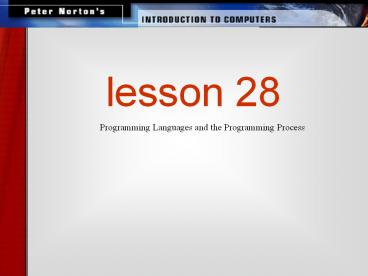Programming%20Languages%20and%20the%20Programming%20Process - PowerPoint PPT Presentation
Title:
Programming%20Languages%20and%20the%20Programming%20Process
Description:
... languages) are the most basic type of computer languages, consisting ... BASIC Java. Pascal ActiveX ... Visual Basic (VB) VisualAge. Authoring environments ... – PowerPoint PPT presentation
Number of Views:183
Avg rating:3.0/5.0
Title: Programming%20Languages%20and%20the%20Programming%20Process
1
lesson 28
Programming Languages and the Programming Process
2
- This lesson includes the following sections
- The Evolution of Programming Languages
- The Systems Development Life Cycle for
- Programming
3
The Evolution of Programming Languages
- To build programs, people use languages that are
similar to human language. The results are
translated into machine code, which computers
understand. - Programming languages fall into three broad
categories
- Machine languages
- Assembly languages
- Higher-level languages
4
The Evolution of Programming Languages - Machine
Languages
- Machine languages (first-generation languages)
are the most basic type of computer languages,
consisting of strings of numbers the computer's
hardware can use. - Different types of hardware use different machine
code. For example, IBM computers use different
machine language than Apple computers.
5
The Evolution of Programming Languages - Assembly
Languages
- Assembly languages (second-generation languages)
are only somewhat easier to work with than
machine languages. - To create programs in assembly language,
developers use cryptic English-like phrases to
represent strings of numbers. - The code is then translated into object code,
using a translator called an assembler.
6
(No Transcript)
7
The Evolution of Programming Languages -
Higher-Level Languages
- Higher-level languages are more powerful than
assembly language and allow the programmer to
work in a more English-like environment. - Higher-level programming languages are divided
into three "generations," each more powerful than
the last
- Third-generation languages
- Fourth-generation languages
- Fifth-generation languages
8
Higher-Level Languages - Third-Generation
Languages
- Third-generation languages (3GLs) are the first
to use true English-like phrasing, making them
easier to use than previous languages. - 3GLs are portable, meaning the object code
created for one type of system can be translated
for use on a different type of system. - The following languages are 3GLs
FORTAN C COBOL C BASIC Java Pascal Activ
eX
9
Higher-Level Languages - Fourth-Generation
Languages
- Fourth-generation languages (4GLs) are even
easier to use than 3GLs. - 4GLs may use a text-based environment (like a
3GL) or may allow the programmer to work in a
visual environment, using graphical tools. - The following languages are 4GLs
Visual Basic (VB) VisualAge Authoring
environments
10
Higher-Level Languages - Fifth-Generation
Languages
- Fifth-generation languages (5GLs) are an issue of
debate in the programming community some
programmers cannot agree that they even exist. - These high-level languages would use artificial
intelligence to create software, making 5GLs
extremely difficult to develop.
11
The Systems Development Life Cycle for
Programming
The SDLC for programming follows the same phases
as the SDLC for information systems development
- Phase 1 Needs Analysis
- Phase 2 Program Design
- Phase 3 Development
- Phase 4 Implementation
- Phase 5 Maintenance
12
lesson 28 review
- Identify the three main categories of programming
languages. - Describe the five generations of programming
languages. - Name at least five major programming languages.
- Describe a visual programming environment and how
it is used. - List the five phases of the software development
life cycle.































